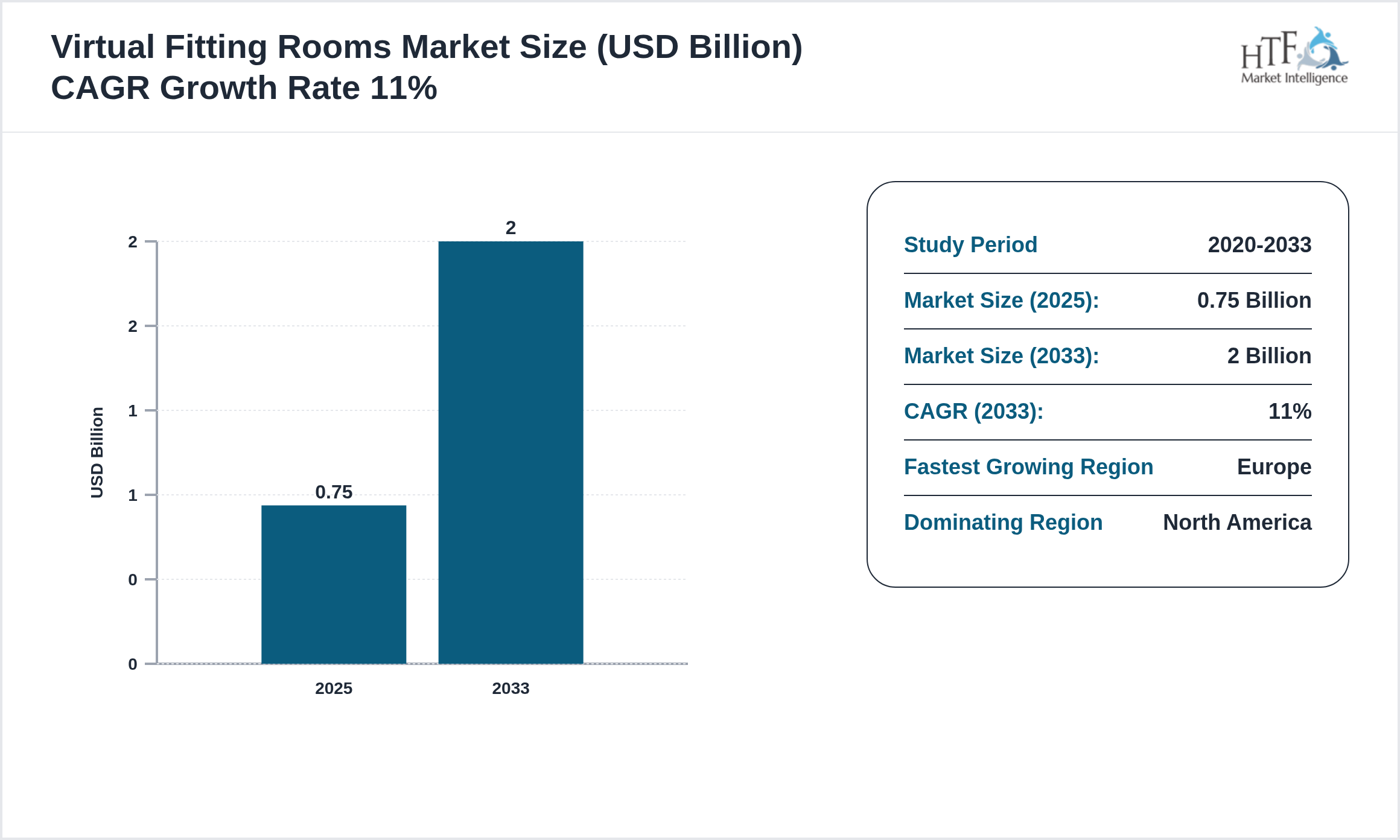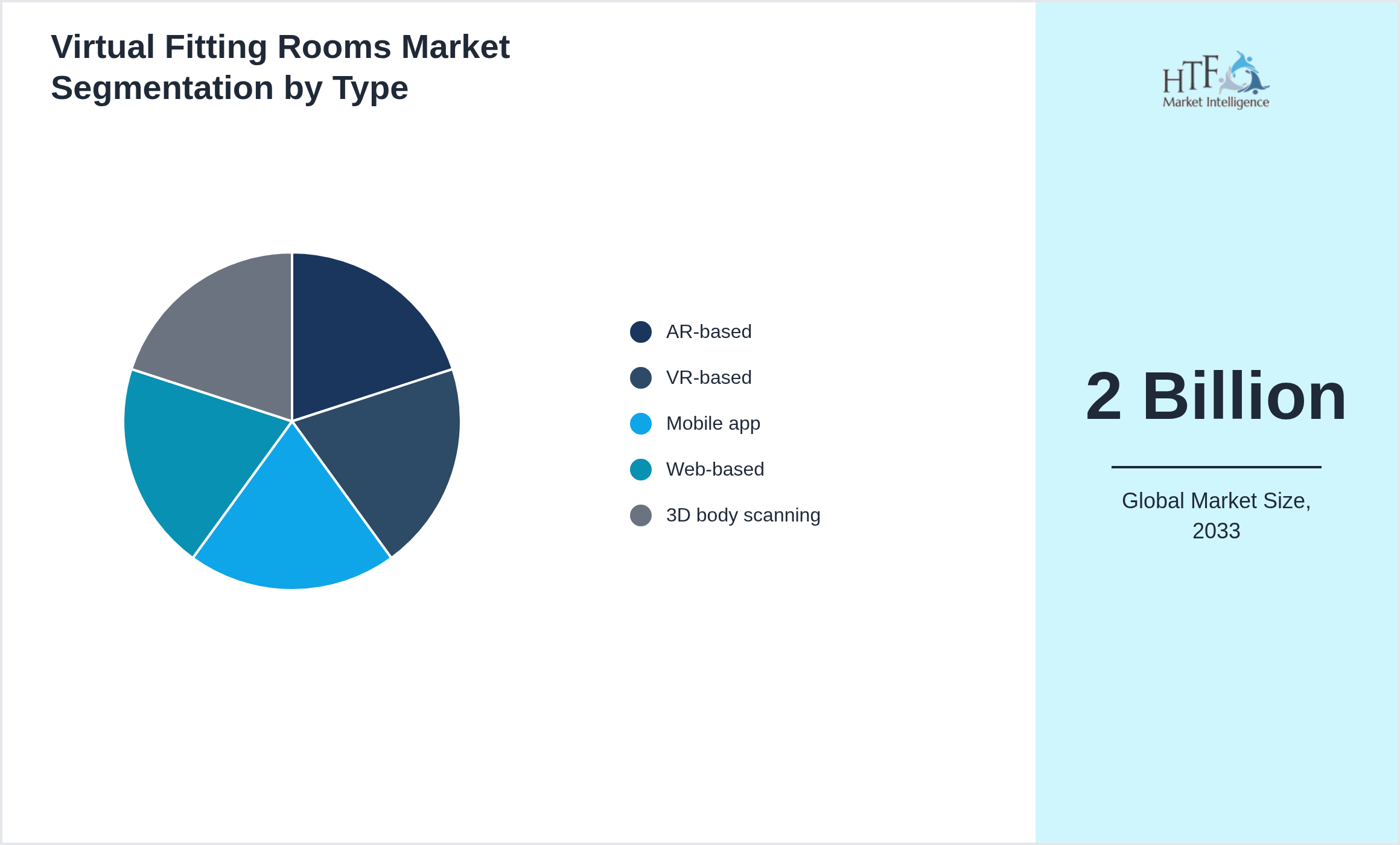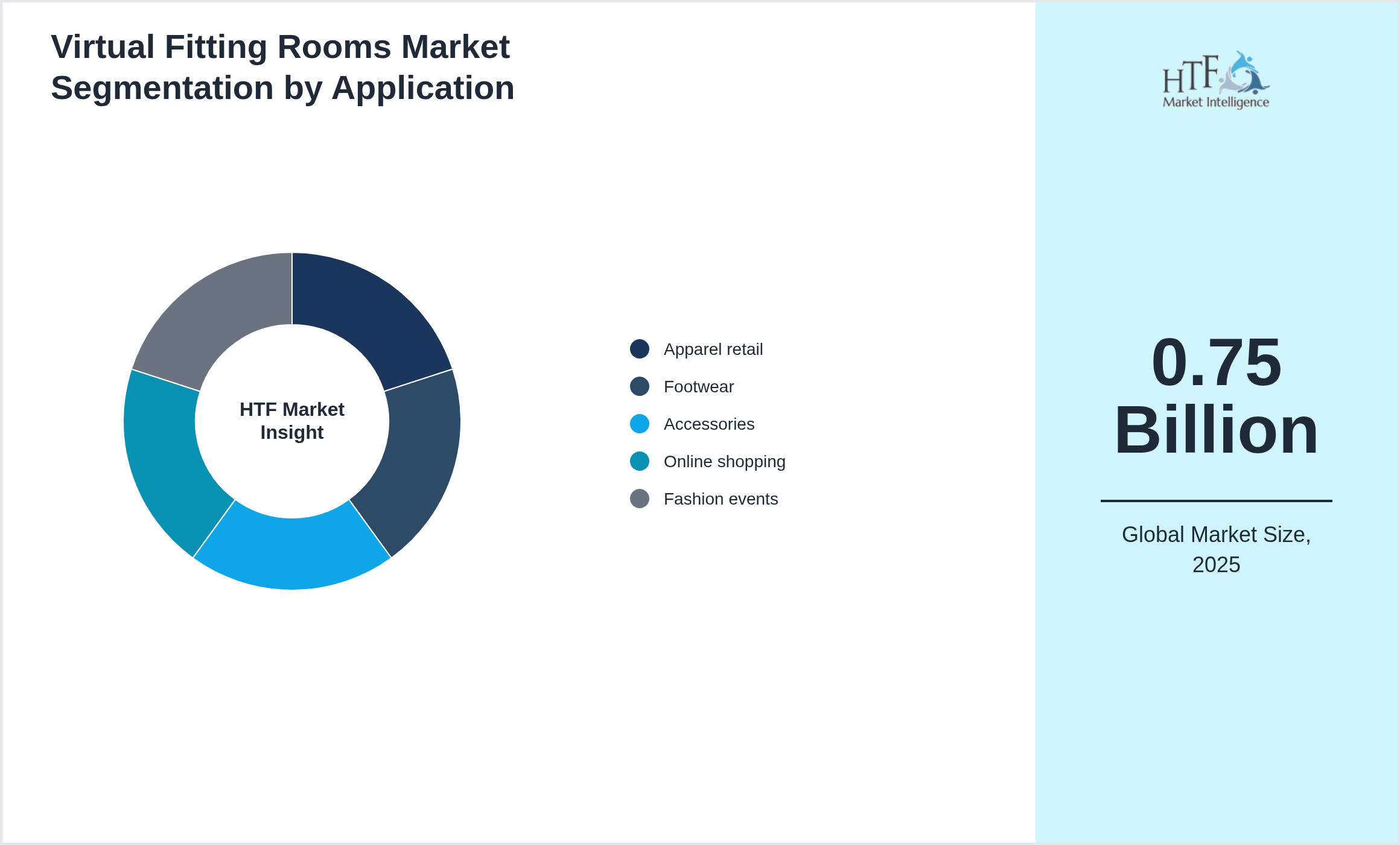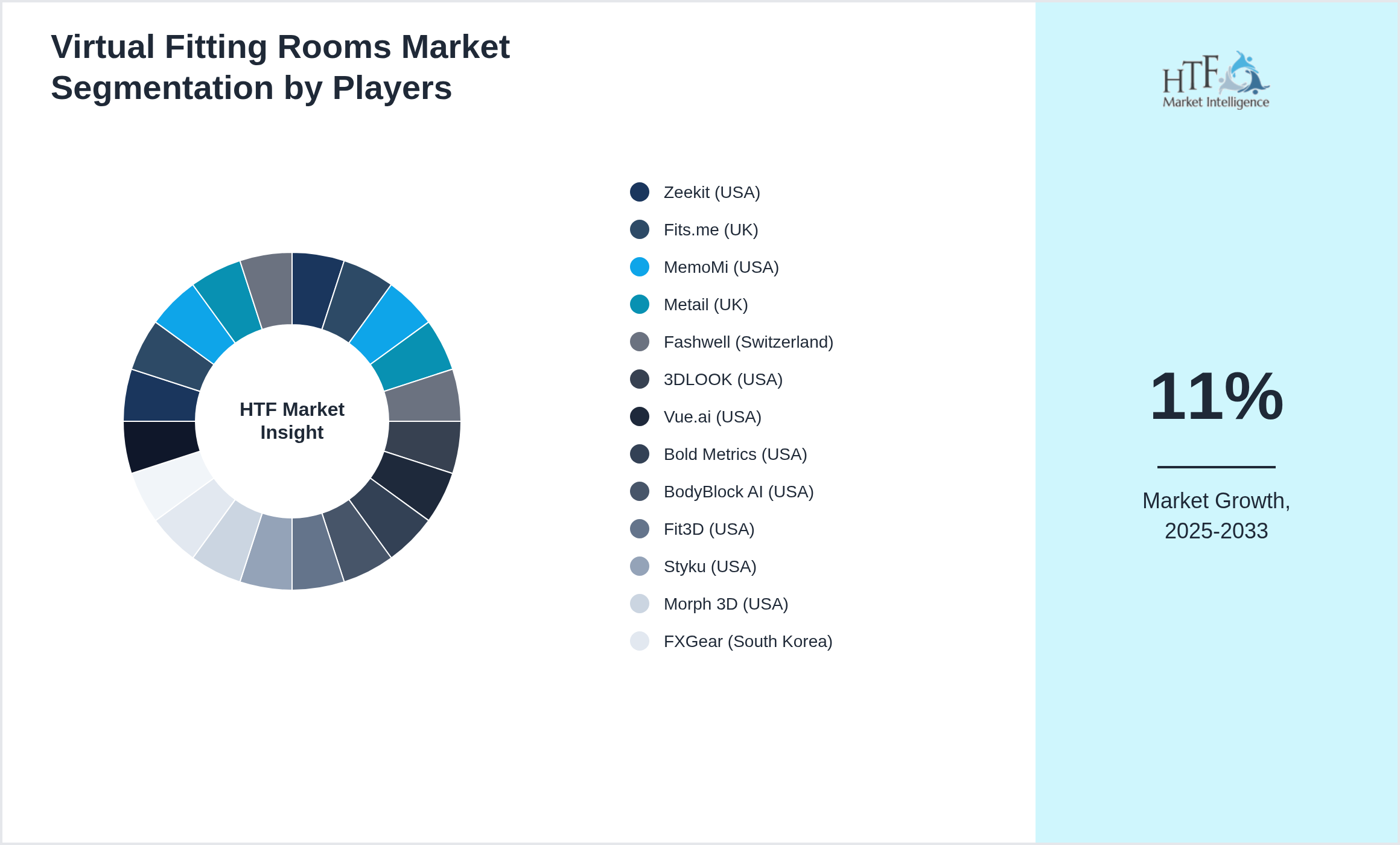Virtual Fitting Rooms Market Research Report
Virtual Fitting Rooms Market Shows Incredible Growth Soon
Global Virtual Fitting Rooms Market is segmented by Application (Apparel retail, Footwear, Accessories, Online shopping, Fashion events), Type (AR-based, VR-based, Mobile app, Web-based, 3D body scanning), and Geography (North America, LATAM, West Europe, Central & Eastern Europe, Northern Europe, Southern Europe, East Asia, Southeast Asia, South Asia, Central Asia, Oceania, MEA)
Pricing
INDUSTRY OVERVIEW
The Virtual Fitting Rooms market is experiencing robust growth, projected to achieve a compound annual growth rate CAGR of 11% during the forecast period. Valued at 0.75 Billion, the market is expected to reach 2 Billion by 2033, with a year-on-year growth rate of 10.50%. This upward trajectory is driven by factors such as evolving consumer preferences, technological advancements, and increased investment in innovation, positioning the market for significant expansion in the coming years. Companies should strategically focus on enhancing their offerings and exploring new market opportunities to capitalize on this growth potential.

Virtual fitting rooms use augmented reality (AR) and AI technologies to allow customers to try on clothes or accessories digitally before purchasing, enhancing online and in-store shopping experiences. This reduces returns and boosts engagement. The trend is growing with e-commerce expansion and consumer demand for personalized experiences.
Regulatory Landscape
- • Governed by data privacy laws for biometric and image data
Regulatory Framework
The Information and Communications Technology (ICT) industry is primarily regulated by the Federal Communications Commission (FCC) in the United States, along with other national and international regulatory bodies. The FCC oversees the allocation of spectrum, ensures compliance with telecommunications laws, and fosters fair competition within the sector. It also establishes guidelines for data privacy, cybersecurity, and service accessibility, which are crucial for maintaining industry standards and protecting consumer interests.
Globally, various regulatory agencies, such as the European Telecommunications Standards Institute (ETSI) and the International Telecommunication Union (ITU), play significant roles in standardizing practices and facilitating international cooperation. These bodies work together to create a cohesive regulatory framework that addresses emerging technologies, cross-border data flow, and infrastructure development. Their regulations aim to ensure the ICT industry's growth is both innovative and compliant with global standards, promoting a secure and competitive market environment.
Key Highlights
• The Virtual Fitting Rooms is growing at a CAGR of 11% during the forecasted period of 2020 to 2033
• Year on Year growth for the market is 10.50%
• Based on type, the market is bifurcated into AR-based, VR-based, Mobile app, Web-based, 3D body scanning
• Based on application, the market is segmented into Apparel retail, Footwear, Accessories, Online shopping, Fashion events
• Global Import Export in terms of K Tons, K Units, and Metric Tons will be provided if Applicable based on industry best practice
Market Segmentation Analysis
Segmentation by Type
- • AR-based
- • VR-based
- • Mobile app
- • Web-based
- • 3D body scanning

Segmentation by Application
- • Apparel retail
- • Footwear
- • Accessories
- • Online shopping
- • Fashion events

Key Players
Several key players in the Virtual Fitting Rooms market are strategically focusing on expanding their operations in developing regions to capture a larger market share, particularly as the year-on-year growth rate for the market stands at 10.50%. The companies featured in this profile were selected based on insights from primary experts, evaluating their market penetration, product offerings, and geographical reach. By targeting emerging markets, these companies aim to leverage new opportunities, enhance their competitive advantage, and drive revenue growth. This approach not only aligns with their overall business objectives but also positions them to respond effectively to the evolving demands of consumers in these regions.
- • Zeekit (USA)
- • Fits.me (UK)
- • MemoMi (USA)
- • Metail (UK)
- • Fashwell (Switzerland)
- • 3DLOOK (USA)
- • Vue.ai (USA)
- • Bold Metrics (USA)
- • BodyBlock AI (USA)
- • Fit3D (USA)
- • Styku (USA)
- • Morph 3D (USA)
- • FXGear (South Korea)
- • Clo Virtual Fashion (South Korea)
- • Virtusize (Sweden)
- • Metail (UK)
- • Zugara (USA)
- • Nettelo (USA)
- • Me-Mode (South Korea)
- • Stylist.ai (USA)

Research Methodology
At HTF Market Intelligence, we pride ourselves on delivering comprehensive market research that combines both secondary and primary methodologies. Our secondary research involves rigorous analysis of existing data sources, such as industry reports, market databases, and competitive landscapes, to provide a robust foundation of market knowledge. This is complemented by our primary research services, where we gather firsthand data through surveys, interviews, and focus groups tailored specifically to your business needs. By integrating these approaches, we offer a thorough understanding of market trends, consumer behavior, and competitive dynamics, enabling you to make well-informed strategic decisions. We would welcome the opportunity to discuss how our research expertise can support your business objectives.
Market Dynamics
Market dynamics refer to the forces that influence the supply and demand of products and services within a market. These forces include factors such as consumer preferences, technological advancements, regulatory changes, economic conditions, and competitive actions. Understanding market dynamics is crucial for businesses as it helps them anticipate changes, identify opportunities, and mitigate risks.
By analyzing market dynamics, companies can better understand market trends, predict potential shifts, and develop strategic responses. This analysis enables businesses to align their product offerings, pricing strategies, and marketing efforts with evolving market conditions, ultimately leading to more informed decision-making and a stronger competitive position in the marketplace.
Market Driver
- • E-Commerce Growth
- • Personalization Demand
- • AR Advancements
- • Return Cost Reduction
- • Mobile Usage
Market Trend
- • AI Styling
- • 3D Scanning
- • Social Commerce
- • Virtual Try-On
- • Integration with Retail Platforms
- • Improved Customer Experience
- • Reduced Returns
- • New Retail Channels
- • Brand Differentiation
- • Data Analytics
Challenge
- • Technology Accuracy
- • User Experience
- • Implementation Costs
- • Privacy
- • Device Compatibility
Regional Analysis
- • Expanding in e-commerce and retail globally
- • June 2024 – Virtual Try-On and Zeekit introduced AI-driven virtual fitting rooms for e-commerce
- • April
- • Governed by data privacy laws for biometric and image data
- • Patents on 3D body scanning
- • Increasing funding from retail tech startups
Regional Outlook
The North America Region holds the largest market share in 2025 and is expected to grow at a good CAGR. The Europe Region is the fastest-growing region due to increasing development and disposable income.
North America remains a leader, driven by innovation hubs like Silicon Valley and a strong demand for advanced technologies such as AI and cloud computing. Europe is characterized by robust regulatory frameworks and significant investments in digital transformation across sectors. Asia-Pacific is experiencing rapid growth, led by major markets like China and India, where increasing digital adoption and governmental initiatives are propelling ICT advancements.
The Middle East and Africa are witnessing steady expansion, driven by infrastructure development and growing internet penetration. Latin America and South America present emerging opportunities, with rising investments in digital infrastructure, though challenges like economic instability can impact growth. These regional differences highlight the need for tailored strategies in the global ICT market.
- North America
- LATAM
- West Europe
- Central & Eastern Europe
- Northern Europe
- Southern Europe
- East Asia
- Southeast Asia
- South Asia
- Central Asia
- Oceania
- MEA
|
Report Features |
Details |
|
Base Year |
2025 |
|
Based Year Market Size (2025) |
0.75 Billion |
|
Historical Period Market Size (2020) |
USD Million ZZ |
|
CAGR (2025 to 2033) |
11% |
|
Forecast Period |
2025 to 2033 |
|
Forecasted Period Market Size (2033) |
2 Billion |
|
Scope of the Report |
AR-based, VR-based, Mobile app, Web-based, 3D body scanning, Apparel retail, Footwear, Accessories, Online shopping, Fashion events |
|
Regions Covered |
North America, Europe, Asia Pacific, South America, and MEA |
|
Year on Year Growth |
10.50% |
|
Companies Covered |
Zeekit (USA), Fits.me (UK), MemoMi (USA), Metail (UK), Fashwell (Switzerland), 3DLOOK (USA), Vue.ai (USA), Bold Metrics (USA), BodyBlock AI (USA), Fit3D (USA), Styku (USA), Morph 3D (USA), FXGear (South Korea), Clo Virtual Fashion (South Korea), Virtusize (Sweden), Metail (UK), Zugara (USA), Nettelo (USA), Me-Mode (South Korea), Stylist.ai (USA) |
|
Customization Scope |
15% Free Customization (For EG) |
|
Delivery Format |
PDF and Excel through Email |
Virtual Fitting Rooms - Table of Contents
Chapter 1: Market Preface
Chapter 2: Strategic Overview
Chapter 3: Global Virtual Fitting Rooms Market Business Environment & Changing Dynamics
Chapter 4: Global Virtual Fitting Rooms Industry Factors Assessment
Chapter 5: Virtual Fitting Rooms : Competition Benchmarking & Performance Evaluation
Chapter 6: Global Virtual Fitting Rooms Market: Company Profiles
Chapter 7: Global Virtual Fitting Rooms by Type & Application (2020-2033)
Chapter 8: North America Virtual Fitting Rooms Market Breakdown by Country, Type & Application
Chapter 9: Europe Virtual Fitting Rooms Market Breakdown by Country, Type & Application
Chapter 10: Asia Pacific Virtual Fitting Rooms Market Breakdown by Country, Type & Application
Chapter 11: Latin America Virtual Fitting Rooms Market Breakdown by Country, Type & Application
Chapter 12: Middle East & Africa Virtual Fitting Rooms Market Breakdown by Country, Type & Application
Chapter 13: Research Finding and Conclusion
Frequently Asked Questions (FAQ):
The Compact Track Loaders market is expected to see value worth 5.3 Billion in 2025.
North America currently leads the market with approximately 45% market share, followed by Europe at 28% and Asia-Pacific at 22%. The remaining regions account for 5% of the global market.
Key growth drivers include increasing construction activities, rising demand for versatile equipment in agriculture, technological advancements in track loader design, and growing preference for compact equipment in urban construction projects.
